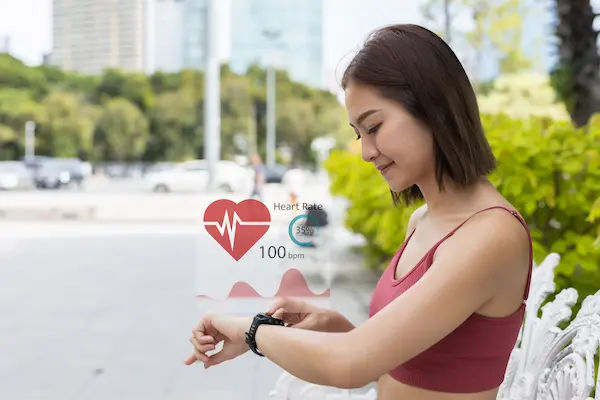Target Heart Rate Calculation Method
know everything about heart rate, its significance, how to measure it and how it is useful for people. Learn the tips for managing an ideal target heart rate.

Written by Dr. J T Hema Pratima
Reviewed by Dr. Shaik Abdul Kalam MD (Physician)
Last updated on 31st Oct, 2025

Introduction
Have you ever wondered how hard your heart should be working during exercise? Whether you're a fitness enthusiast or just starting your health journey, understanding your target heart rate (THR) can help you exercise safely and effectively.
Your target heart rate is the ideal range of heartbeats per minute (bpm) during physical activity to maximise cardiovascular benefits without overexerting yourself.
In this article, we’ll explain what the target heart rate is, how to calculate it, and why it matters for your health.
What Is Target Heart Rate?
Your target heart rate (THR) is the recommended heart rate range you should aim for during exercise to get the most out of your workout. Staying within this range ensures that your heart is working hard enough to improve fitness but not so hard that it becomes unsafe.
Consult Specialist Cardiologist for healthy living.
Why Is It Important?
Maintaining a target heart rate has several advantages, which are listed below:
Helps you exercise efficiently—not too easy, not too hard.
Improves heart health by strengthening the cardiovascular system.
Burns calories effectively for weight management.
Reduces the risk of overexertion and potential injuries.
How to Calculate Your Target Heart Rate?
Calculating your target heart rate is simple. Here’s a step-by-step method:
Step 1: Find Your Maximum Heart Rate (MHR)
The general formula is:
MHR = 220 – Your Age
For example, if you are 40 years old:
MHR = 220 – 40 = 180 bpm
Step 2: Determine Your Target Heart Rate Zone
Your THR zone is usually 50% to 85% of your MHR, depending on your fitness level:
Moderate Exercise (50–70% of MHR) – Good for beginners or light workouts.
Vigorous Exercise (70–85% of MHR) – Best for improving endurance and burning more calories.
Example Calculation (for a 40-year-old):
Moderate Zone (50–70%):
Lower limit: 180 × 0.50 = 90 bpm
Upper limit: 180 × 0.70 = 126 bpm
Vigorous Zone (70–85%):
Lower limit: 180 × 0.70 = 126 bpm
Upper limit: 180 × 0.85 = 153 bpm
So, a 40-year-old should aim for 90–126 bpm for moderate exercise and 126–153 bpm for intense workouts.
Alternative Method: The Karvonen Formula (More Personalised)
This method considers your resting heart rate (RHR), making it more accurate. Find below the step-by-step procedure
Step 1. Measure your resting heart rate (RHR) (best taken in the morning before getting out of bed).
Step 2. Calculate Heart Rate Reserve (HRR):
HRR = MHR – RHR
Step 3. Multiply HRR by intensity% % and add RHR:
Step 4. Lower limit: (HRR × 0.50) + RHR
Step 5. Upper limit: (HRR × 0.85) + RHR
Example (RHR = 60 bpm, Age = 40):
HRR = 180 (MHR) – 60 (RHR) = 120
Moderate Zone (50–70%):
Lower: (120 × 0.50) + 60 = 120 bpm
Upper: (120 × 0.70) + 60 = 144 bpm
This gives a slightly different but more tailored range.
How to Measure Your Heart Rate During Exercise?
You can check your heart rate in two ways:
1. Manual Pulse Check
Place two fingers on your wrist (radial artery) or neck (carotid artery). Count the beats for 15 seconds and multiply by 4 to get bpm.
2. Using a Heart Rate Monitor
Fitness trackers (like smartwatches) provide real-time heart rate data. Chest strap monitors are more accurate for intense workouts.
Who Should Be Careful with Target Heart Rate?
While THR is useful, some people should consult a doctor before relying on it:
Heart disease patients
Hypertension (high BP) patients
Those on certain medications (e.g., beta-blockers)
Pregnant women
People with chronic conditions (diabetes, asthma, etc.)
If you have any concerns, it’s best to consult a doctor before starting a new exercise routine.
Tips for Exercising Within Your Target Heart Rate
1. Start Slow – If you’re new to exercise, aim for the lower end (50–60%) of your THR.
2. Warm Up & Cool Down – Gradually increase and decrease intensity.
3. Stay Hydrated – Dehydration can affect heart rate.
4. Listen to Your Body – If you feel dizzy or overly tired, slow down.
5. Adjust for Fitness Level – As you get fitter, you may need to increase intensity.
When to Seek Medical Advice?
When you experience:
Chest pain during exercise
Extreme shortness of breath
Irregular heartbeat (palpitations)
Dizziness or fainting
Stop exercising immediately and consult a doctor.
Final Thoughts
Knowing your target heart rate helps you exercise smarter, not harder. Whether you're walking, running, or cycling, staying within your ideal range ensures you get the most benefits while keeping your heart safe.
Consult Specialist Cardiologist for healthy living.
Consult Specialist Cardiologist for healthy living.
Dr. Praveen Jaiswal
Cardiologist
17 Years • MD(Medicine), DM(Cardiology)
Indore
Apollo Hospitals Vijay Nagar, Indore

Dr. Dayanashre N
General Physician
3 Years • MBBS
Bengaluru
PRESTIGE SHANTHINIKETAN - SOCIETY CLINIC, Bengaluru

Dr. Sumanta Chatterjee
Cardiologist
12 Years • MBBS,MD General Medicine,DM Cardiology
Kolkata
HealthYou Speciality Clinic & Diagnostics., Kolkata
(25+ Patients)
Dr. Mahendranath Subramani Prasad
Cardiologist
16 Years • MBBS,MS ,DNB, M.Ch. Cardiovascular and Thoracic Surgery(Cardiology)
Bengaluru
Apollo Clinic, Sarjapur Road, Bengaluru

Dr. Sarita Rao
Cardiologist
17 Years • MBBS, DM (Cardiology)
Indore
Apollo Hospitals Vijay Nagar, Indore



